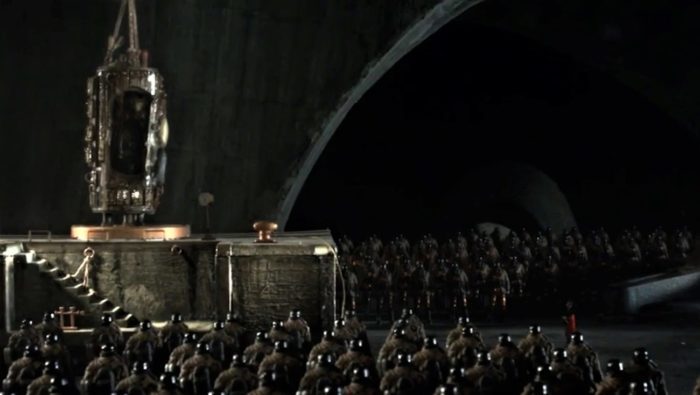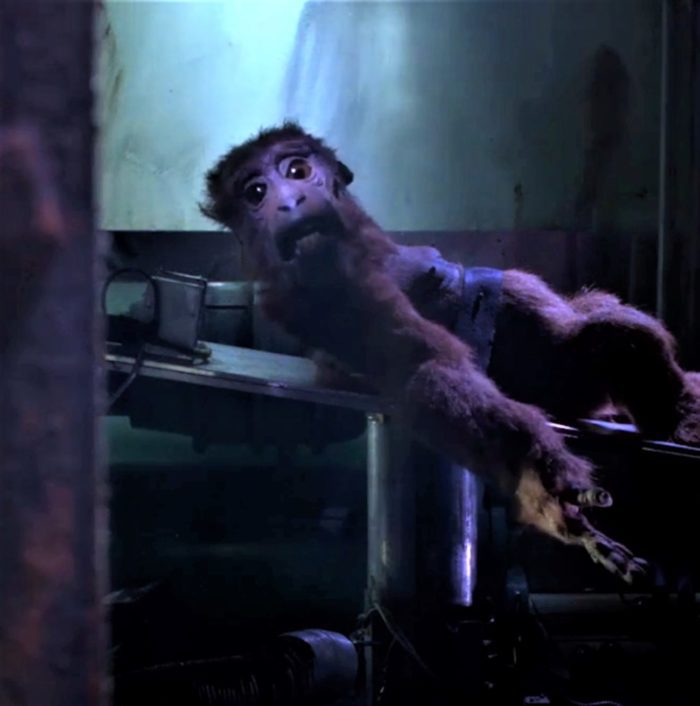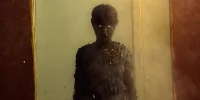It won’t be long before a cult grows around Mad God. Award-winning visual effects artist Phil Tippett has delivered a dystopian nightmare that will surely enthrall as many as it alienates. Those captivated by Mad God’s surreal grim fantasy are guaranteed a buffet of horrific visuals and implicative imagery. Those repulsed may not enjoy the film but are unlikely to ever forget its haunting scenes. All in all, the movie leaves a lasting impression on whoever dares to witness it. Few modern movies can ensure that they will be so unforgettable.
Mad God opens with a character dubbed The Assassin. As the Locarno Film Festival stated when the movie premiered there in 2021, “a corroded diving bell descends amidst a ruined city and the Assassin emerges from it to explore a labyrinth of bizarre landscapes inhabited by freakish denizens.” Those barebones barely prepare for the phantasmagoric panoply about to unfold. However, that simple statement delivers more plot than the whole film will.
There is essentially zero dialogue throughout. While what characters are doing is obvious, their motivations are often opaque at best. It’s tricky to call this lack of concrete plot a weakness. For instance, who or what the Assassin is trying to assassinate is never fully addressed. Though some might prefer a more defined narrative, others are likely to revel in the implication of a plot. It’ll allow them to make the movie their own, and in a way, that is much more entertaining. Suffice it to say, Mad God is carried along by dream logic hinting at a structured narrative.
Oddly enough, as unreal as the realm seems, it feels like a real place. There is a grounded quality to the living machines and deformed entities which populate Mad God. None are weird for the sake of weird. They function within their scenes furthering the chain of events and allowing the audience to explore this strange universe alongside the Assassin.

As such, questions abound while watching Mad God. This is, overall, a cerebral fantasy, fueled by a grim logic behind its brutality. Fortunately, whenever gruesome, nothing is done simply for shock value. A scene of torturous dissection enfolds not to splash blood and guts around but to reach the next part of the nightmare. Then the story, to what extent it exists, carries on thanks to a melancholy momentum. Nothing stops events from happening. Even death barely causes a pause, regardless of the scale or apparent suffering. Corpses compose towering mounds and screams of agony ring out from all around, but the world continues without blinking an eye. The viewer is given the sense there is no end—only forward, plunging ever deeper into the dark.
That descent into Mad God reveals a land where the organic and industrial blend together, sometimes on a surreal scale. This is a post-industrial realm of giants, titanic factories, and epic abominations. As Tippett Studios put it in a teaser trailer, “a Miltonesque world of monsters, mad scientists, and war pigs.” Terrifying totems made of bones and wire, unsettling grim vistas suggesting vast expanses, cavernous ruins running deep, deep underground—Mad God is a visually stunning film. An experimental stop-motion feature such as this is a technical achievement without question. More importantly, though, it tugs at the heart in unexpected ways.

At the risk of spoilers, monsters shown demolishing one another are revealed not to be mindless brutes but tortured beings overwhelmed by agony and anger. Hideous entities are shown to be pitiably helpless, or the source of cosmic beauty. What lives in this realm is always twisted, tainted in some way profoundly unsettling, yet at times, an undercurrent of tragedy is obvious. Beings in Mad God aren’t presented as evil, but rather, as the tragic consequences of the environment they inhabit.
I feel certain some audiences are going to spend hours debating and dissecting the meaning inherent in a variety of the film’s elements. Descent into madness is obvious, of course, but there are other layers as well which make Mad God an interesting choice for movie night. Friends gathered in the dark, huddled around a glowing screen as a nightmarish industrial complex grinds faceless entities out of existence. When they literally feed themselves to the fires of industry, is it to escape this horrid reality or because they have a sacrificial devotion to the machine?
Some, however, may come simply to see the marvelous effects work. Mad God is an amazing blend of live-action alongside stop-motion, though the latter dominates no doubt. Described as a passion project spanning almost thirty years, it is the brainchild of a legendary visual FX artist.

Phil Tippett is best known for his work in Star Wars. When it comes to stop-motion, his innovations at the time not only advanced the art form but helped the original trilogy truly come to life. Later, he worked on Jurassic Park, and although filmmakers chose not to use stop-motion, Tippett stayed on as a consultant for computer animators. It’s not a stretch to suggest his insights are what helped make the CGI dinosaurs so life-like that the first film in the franchise stands up even today. The point is that Phil Tippett is a master of his craft, a fact on full display in Mad God.
The movie is a feast for the eyes. Though it must be said, the lack of dialogue demands constant attention. On the one hand, there’s always something to see. The filmmakers have done an excellent job of including details in the background which convey the sense of a living world, one that carries on even when the camera isn’t there, but the constant onslaught of extreme imagery can be overwhelming. It’s possible to get a tad mentally exhausted watching Mad God, and in my opinion, it’s because nothing is ever spoon-fed to the audience.

Every moment in the movie not only needs to be ingested but processed. There’s no character saying what’s happening, so while watching, the viewer is also interpreting, or deducing events. Some will find that unappealing. Others will find it immensely refreshing.
Personally, I think that makes it an interesting film. There’s no aspiration to satisfy the broadest audience possible. It challenges the viewer rather than coddles them. This is the expression of one artist’s vision, offered to whatever viewer is willing to risk watching. Frankly, it’s rare to see such an unrestrained demonstration of unbridled imagination.
Mad God is unlikely to appeal to all. The lack of dialogue, symbolic storytelling over an actual plot, and the generally hideous nature of certain scenes are bound to divide viewers. Still, even they should consider seeing it just to experience the brilliance of its visual and technical achievements. That said, there is certainly a group who will dive deep into the depths of this insanity, and from them will rise a cult thoroughly devoted to Phil Tippett’s Mad God.



